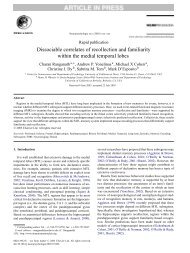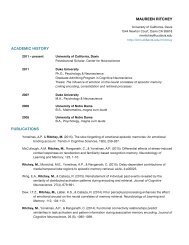CLINICAL EEG and NEUROSCIENCE - Dynamic Memory Lab
CLINICAL EEG and NEUROSCIENCE - Dynamic Memory Lab
CLINICAL EEG and NEUROSCIENCE - Dynamic Memory Lab
You also want an ePaper? Increase the reach of your titles
YUMPU automatically turns print PDFs into web optimized ePapers that Google loves.
<strong>CLINICAL</strong> <strong>EEG</strong> <strong>and</strong> <strong>NEUROSCIENCE</strong> ©2007 VOL. 38 NO. 1symptoms, more perinatal complications, poor premorbidadjustment <strong>and</strong> a higher risk of developing tardive dyskinesia.The majority of patients showing tardive dyskinesiaat the time of the recording also presented with a smallP300. Even more interesting is the finding that patientswho developed tardive dyskinesias during a 2 years follow-upperiod had already significantly smaller P300 at thebeginning of the prospective study. 3 0 A small P300 hasbeen found to predict nonresponse to neuroleptics concerningpositive symptoms <strong>and</strong> a prolonged P300 latencyhas been found to predict non-response concerning negativesymptoms. 2 3 S i m i l a r l y, Strik et al 3 1 - 3 3 found thatpatients with a “cycloid psychosis” (according to the classificationby Leonhard), which is characterized by a favorabletherapeutic response <strong>and</strong> long-term prognosis, haveno reduction of P300 amplitude or even an increase inamplitude compared to healthy subjects. Furthermore, instudies on stabilized schizophrenic outpatients it is a quiteconsistent finding that patients with small P300 have moreresidual symptoms, mainly negative symptoms <strong>and</strong>thought disorders.P300 <strong>and</strong> psychopathologyFor the evaluation of the relationship between P300<strong>and</strong> psychopathology, it is of crucial importance to independentlystudy stabilized patients <strong>and</strong> acutely psychoticpatients. In stabilized patients, it is a quite consistent findingthat P300 amplitude is negatively correlated with residualsymptoms. This association does not reflect statedependent effects of residual symptoms on P300 butrather the poor outcome of a subgroup of patients withsmall P300. This interpretation is supported by a study ofschizophrenic patients, retested after 9 months. Here theintra-individual changes of psychopathology were not relatedto the corresponding changes of P300 amplitude. 27However, the P300 component reflects both trait <strong>and</strong>state aspects such as psychopathology. Several studies onacutely psychotic patients reported positive correlationsbetween P300 amplitudes <strong>and</strong> the severity of positivesymptoms. However, the literature is not entirely consistenton this issue, which can be explained by differences in theseverity of the acute symptomatology. It has to be expectedthat patients with severe acute symptoms leading toimpaired attention, will have difficulties to cooperate <strong>and</strong> toperform the P300 oddball paradigm. 34-36In summary, a small P300 in schizophrenic patientshas been found to be a vulnerability marker characterizinga subgroup of patients with a poor premorbid adjustment,an enhanced risk of developing tardive dyskinesia, moreresidual symptoms <strong>and</strong> a poor outcome. Concerning theevaluation of the relationship between psychopathology<strong>and</strong> P300, it is of importance to control the studies forremitted versus acutely psychotic patients, predominanceof positive versus negative symptoms <strong>and</strong> to differentiatethe P300 subcomponents P3a <strong>and</strong> P3b.Affective disordersAn amplitude reduction of P300 has been found indepressed patients although the literature is not consistenton this issue. Some authors found changes of P300 only ina subgroup of patients, mainly in those with severe or psychoticdepression. 37,38It is a replicated finding that patients with depressive disorderswith suicide attempts showed smaller P300 amplitudesthan depressive patients without suicide attempts. Inaddition a correlation has been reported between acute suicidality<strong>and</strong> P300 amplitude. 3 9 A convincing explanation forthis relationship has not been given up to now.Alzheimer’s diseaseP300 is an interesting instrument for studyingA l z h e i m e r’s disease, because latency <strong>and</strong> amplitude ofP300 are closely related to cognitive processes <strong>and</strong> tocholinergic function. Furthermore P300 is cortically generated<strong>and</strong> A l z h e i m e r’s disease impairs especially cortical functioning.It is therefore not surprising that A l z h e i m e r’s diseaseis related in a consistent manner with smaller P300amplitudes <strong>and</strong> prolonged P300 latencies. Such changescan be observed even in patients with mild A l z h e i m e r’s disea s e . 4 0 , 4 1 In studies, comparing demented patients with psychiatric<strong>and</strong> neurological patients without dementia, thespecificity of P300 latencies was above 80 % whereas thesensitivity was relatively poor, ranging between 15 <strong>and</strong>80%. As expected, studies with more severely dementedpatients reported higher sensitivities. Auditory P300 latencieswere superior to visual P300 latencies concerning therecognition of patients with A l z h e i m e r’s disease.In a prospective, confirmatory study to evaluate the clinicalrelevance of the P300 in the early diagnosis of A D ,Frodl et al 4 2 investigated patients with AD, mild cognitiveimpairment (MCI) <strong>and</strong> healthy controls (HC) using P300assessments with dipole source analysis. The authorscould demonstrate that the amplitudes of temporo-basaldipoles (equivalent to the P3b subcomponent) were statisticallysignificantly decreased in AD as compared to both HC<strong>and</strong> MCI. Furthermore, the latencies of superior temporaldipoles (equivalent to P3a) were significantly prolonged inAD compared with HC. The significant differences remainedstable after stratification of the patients regarding the severityof the disease: Even patients with mild AD showedmarked, significant reductions in P300 amplitudes. T h esensitivity <strong>and</strong> specificity for the differentiation of A Dpatients <strong>and</strong> HC using temporo-basal P300-amplitudes <strong>and</strong>superior temporal P300-latencies were as high as 86.7%,<strong>and</strong> 88.5%, respectively, which is comparable to other(often less validated) biological diagnostic markers in A D .The P300 is related to cholinergic neurotransmission<strong>and</strong> may therefore be useful to identify subgroups with amore circumscribed cholinergic dysfunction. This subgroupmay turn out to show a favorable response to a treatmentwith cholinesterase inhibitors.27




